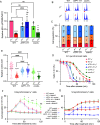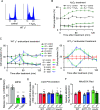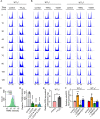Mitochondrial membrane potential acts as a retrograde signal to regulate cell cycle progression
- PMID: 37696576
- PMCID: PMC10494934
- DOI: 10.26508/lsa.202302091
Mitochondrial membrane potential acts as a retrograde signal to regulate cell cycle progression
Abstract
Mitochondria are central to numerous metabolic pathways whereby mitochondrial dysfunction has a profound impact and can manifest in disease. The consequences of mitochondrial dysfunction can be ameliorated by adaptive responses that rely on crosstalk from the mitochondria to the rest of the cell. Such mito-cellular signalling slows cell cycle progression in mitochondrial DNA-deficient (ρ0) Saccharomyces cerevisiae cells, but the initial trigger of the response has not been thoroughly studied. Here, we show that decreased mitochondrial membrane potential (ΔΨm) acts as the initial signal of mitochondrial stress that delays G1-to-S phase transition in both ρ0 and control cells containing mtDNA. Accordingly, experimentally increasing ΔΨm was sufficient to restore timely cell cycle progression in ρ0 cells. In contrast, cellular levels of oxidative stress did not correlate with the G1-to-S delay. Restored G1-to-S transition in ρ0 cells with a recovered ΔΨm is likely attributable to larger cell size, whereas the timing of G1/S transcription remained delayed. The identification of ΔΨm as a regulator of cell cycle progression may have implications for disease states involving mitochondrial dysfunction.
© 2023 Gorospe et al.
Conflict of interest statement
The authors declare that they have no conflict of interest.
Figures











Similar articles
-
Mitochondrial biogenesis: pharmacological approaches.Curr Pharm Des. 2014;20(35):5507-9. doi: 10.2174/138161282035140911142118. Curr Pharm Des. 2014. PMID: 24606795
-
Rad53 is essential for a mitochondrial DNA inheritance checkpoint regulating G1 to S progression.J Cell Biol. 2012 Sep 3;198(5):793-8. doi: 10.1083/jcb.201205193. Epub 2012 Aug 27. J Cell Biol. 2012. PMID: 22927468 Free PMC article.
-
Radon-induced reduced apoptosis in human bronchial epithelial cells with knockdown of mitochondria DNA.J Toxicol Environ Health A. 2012;75(18):1111-9. doi: 10.1080/15287394.2012.699841. J Toxicol Environ Health A. 2012. PMID: 22891884 Free PMC article.
-
Multifaceted roles of mitochondrial stress responses under ETC dysfunction - repair, destruction and pathogenesis.FEBS J. 2022 Nov;289(22):6994-7013. doi: 10.1111/febs.16323. Epub 2021 Dec 26. FEBS J. 2022. PMID: 34918460 Review.
-
Power to the daughters - mitochondrial and mtDNA transmission during cell division.Biol Chem. 2020 Apr 28;401(5):533-546. doi: 10.1515/hsz-2019-0337. Biol Chem. 2020. PMID: 31812944 Review.
Cited by
-
Mitochondrial energy state controls AMPK-mediated foraging behavior in C. elegans.Sci Adv. 2024 Apr 19;10(16):eadm8815. doi: 10.1126/sciadv.adm8815. Epub 2024 Apr 17. Sci Adv. 2024. PMID: 38630817 Free PMC article.
-
Biochanin‑A as SIRT‑1 modulator in preventing statin‑associated diabetogenesis: An in vitro study.Biomed Rep. 2025 Mar 24;22(5):91. doi: 10.3892/br.2025.1969. eCollection 2025 May. Biomed Rep. 2025. PMID: 40171401 Free PMC article.
-
Mitochondrial membrane hyperpolarization modulates nuclear DNA methylation and gene expression through phospholipid remodeling.Nat Commun. 2025 Apr 29;16(1):4029. doi: 10.1038/s41467-025-59427-5. Nat Commun. 2025. PMID: 40301431 Free PMC article.
-
Donafenib Induces Mitochondrial Dysfunction in Liver Cancer Cells via DRP1.Cell Biochem Biophys. 2025 Jun;83(2):2379-2388. doi: 10.1007/s12013-024-01648-4. Epub 2025 Feb 12. Cell Biochem Biophys. 2025. PMID: 39937366
-
Metformin regulates cellulase production in Trichoderma reesei via calcium signaling and mitochondrial function.Microb Cell Fact. 2024 Nov 21;23(1):314. doi: 10.1186/s12934-024-02593-w. Microb Cell Fact. 2024. PMID: 39574147 Free PMC article.
References
Publication types
MeSH terms
Substances
LinkOut - more resources
Full Text Sources
Molecular Biology Databases
